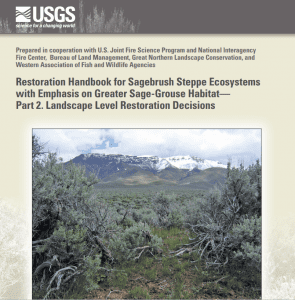Research and Publications
View article.
This study analyzed seasonal variation in the relative availability of soil water for the years 2001, 2004, and 2007, representing respectively, low, moderate, and high rankings of areas burned. For these selected years, the model predicted where forest fires >1 km occurred and did not occur at ~100,000 randomly located pixels with an average accuracy of 69%. The model identified four seasonal combinations, most of which included exhaustion of available water storage capacity during the summer as critical; two combinations involving antecedent conditions the previous spring or fall accounted for 86% of the predicted fires. The approach introduced in this paper can help identify forested areas where management efforts to reduce fire hazards might prove most beneficial.
View report.
This study compared trees in 6- to 28-year-old burned and unburned sites in the third drought year in mixed conifer forests at low elevation in Kings Canyon, Sequoia, and Yosemite national parks in California, USA. Common conifer species found in the burned plots had significantly reduced probability of mortality compared to unburned plots during the drought. Stand density was significantly lower in burned versus unburned sites, supporting the idea that reduced competition may be responsible for the differential drought mortality response.
View article.
In this article, researchers report a dramatic population number expansion of Salsola ryanii in the decade since it was originally documented. Salsola ryanii has every indication of being just as invasive as its highly invasive parents.
View article.
In this Live Science article, Francis Kilkenny, lead of Great Basin Native Plant Project (GBNPP), shares information about the GBNPP and how it continues to support more successful rangeland restoration.
Lessons learned, so far include:
- Climate is more important than geography when predicting how well seeds will grow and establish themselves. Seeds don’t care where their parents lived if the temperature suits them and if they get the right amount of sunshine and precipitation.
- Timing of seed planting makes a big difference. Year to year, even week to week, variation in weather patterns can affect the restoration success of a burned site.
- Method of planting matters. To achieve the best results, scientists recommend tamping seeds into the ground to ensure they have good contact with the soil, or in some cases, planting a species in the form of “plugs.”
- Long-term monitoring after planting is critical to determine the effectiveness of different seed mixes and restoration techniques.
- Keeping livestock off seeded rangeland for at least three years improves a restoration effort’s likelihood of success.
Effects of drought on forests and rangelands in the United States: A comprehensive science synthesis
View synthesis.
This assessment establishes the scientific foundation needed to manage for drought resilience and adaptation. Focal areas include drought characterization; drought impacts on forest processes and disturbances such as insect outbreaks and wildfire; and consequences for forest and rangeland values. Large, stand-level impacts of drought are already underway in the West, but all U.S. forests are vulnerable to drought. Drought-associated forest disturbances are expected to increase with climatic change. Management actions can either mitigate or exacerbate the effects of drought. A first principal for increasing resilience and adaptation is to avoid management actions that exacerbate the effects of current or future drought. Options to mitigate drought include altering structural or functional components of vegetation, minimizing drought-mediated disturbance such as wildfire or insect outbreaks, and managing for reliable flow of water.
View article.
This study suggests that introduced species have disproportionately expanded their ranges upward in elevation over the past century when compared with native species. While these shifts in introduced species may not be exclusively driven by climate, they highlight the importance of considering the interacting factors of climate-driven range shifts and invasion to understand how floras are responding in the face of anthropogenic change.
View synthesis.
This report synthesizes existing extreme fire behavior knowledge in a way that connects the weather, fuel, and topographic factors that contribute to development of extreme fire behavior. It focuses on the state of the science but also considers how that science is currently presented to the fire management community, including incident commanders, fire behavior analysts, incident meteorologists, National Weather Service office forecasters, and firefighters.
View article.
The purpose of this paper is to recommend a framework and methodology for incorporating hydrologic data and ecohydrologic relationships in Ecological Site Descriptions (ESDs) and thereby enhance the utility of ESDs for assessing rangelands and guiding resilience-based management strategies. The proposed framework increases the utility of ESDs to assess rangelands, target conservation and restoration practices, and predict ecosystem responses to management. The proposed enhancement of ESDs will improve communication between private land owners and resource managers and researchers across multiple disciplines in the field of rangeland management.
View handbook.
This handbook is intended to assist decision makers in determining landscape objectives, to identify and prioritize landscape areas where sites for priority restoration projects might be located, and to aid in ultimately selecting restoration sites guided by criteria used to define the landscape objectives. The landscape restoration decision tool is structured in five sections that should be addressed sequentially. Each section has a primary question or statement followed by related questions and statements to assist the user in addressing the primary question or statement.


